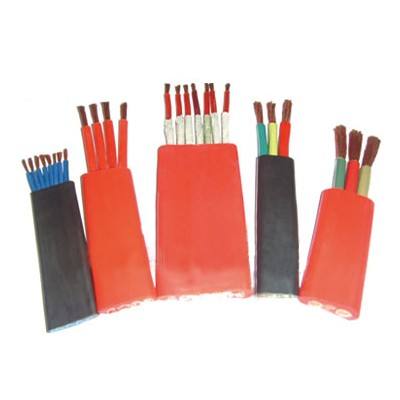Silicone rubber flat cable YVFPB YFFPB standards:
1.Flat cable implementation standard The flame retardant and fire resistance test is carried out according to EU IEC 60332-1-2 standard
2. Flat cable conductors and cores are twisted with tc thermocouple a soft structure to ensure good cable flexibility.
3. Insulation and protective layer materials are made of nitrile polymer and polyurethane to ensure and improve the cable’s softness, corrosion resistance and cold resistance.
Two: Production in custom range:
1.AC rated voltage: U0 / U 0.6 / 1KV and below
2. The installation and laying temperature of conventional flat cable products is: -25 ℃ ~ 70 ℃, and the customizable range is -60 ℃ ~ 180 ℃.
3. Allowable bending radius of cable: The cable is smaller than 15 times the thickness of the cable.
4. Wire ropes or other load-bearing components can be added on both sides of the core according to customer needs.
5. Insulated wire core can be provided with numbers and colors to customize, which is convenient for laying and installation
Silicone rubber flat cable YVFPB YFFPB Technical Parameters:
1. Working voltage: 0.6 / 1Kv
2. Test voltage: 3000v
3. Temperature range: fixed installation: -25 ° C to 80 ° C mobile installation: -45 ° C to 80 ° C
4. Burning test: self-extinguishing flame retardant,thermocouple manufacturers in accordance with DIN VDE0482 part 265-2-1
5. Insulation resistance:> 10G Ω × cm
1 Preparation
1.1 Prepare samples according to relevant technical requirements. The samples should be no less than 5m. YVFB-YVFBP-YVFBPG flat cable
1.2 Check whether the temperature and temperature of the test environment are within the allowable range.
1.3 Check whether the temperature of the thermostatic water bath meets the requirements and whether it is constant.
1.4 Check whether the battery voltage of the insulation resistance tester is within the allowable range.
2 Operating procedures
2.1 The sample is placed in a water bath, and the two ends of the wire should extend no less than 200mm. One of the ends of the wire strips off the insulation layer to expose the conductive wire core. The tester’s high-voltage output electrode is connected to it, and the tester’s measurement input electrode is placed In the water bath.
.2 Turn the output voltage selection switch to the required voltage range, the range switch to the “X105” position, the function selection switch to the “zero adjustment” miniature sheathed thermocouple position, turn on the power switch, and adjust the zero adjustment rotation so that the reading is displayed as zero.
2.3 After zeroing, turn the function selection switch to the “measurement range” range selection switch to the appropriate position, read the reading, the display shows “∽” to indicate underrange, and “I” to indicate overrange. YVFB-YVFBP-YVFBPG flat cable
2.4 After the reading is completed, be sure to turn the “charge and discharge” switch to the “discharge” position, wait for a while before disconnecting the power supply and removing the wire under test.
2.5 When repeating the measurement on the same wire, the wire must be fully discharged before the second retest.
3 matters needing attention Armored thermal resistance
3.1 During the measurement, the human body cannot touch the test sample to prevent electric shock. YVFB-YVFBP-YVFBPG flat cable
3.2 When measuring, do not short the two ends of the tested wire.
3.3 The place where the instrument is placed should be dry and ventilated, and the battery should be removed when it is not used for a long time.
http://www.tiankangcable.com
http://www.tksiliconerubbercable.com
http://www.chinathermocouple.com